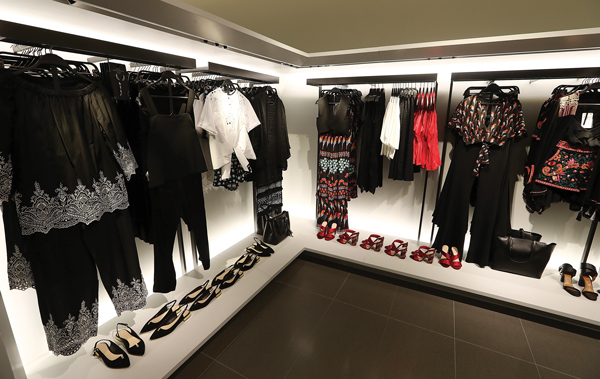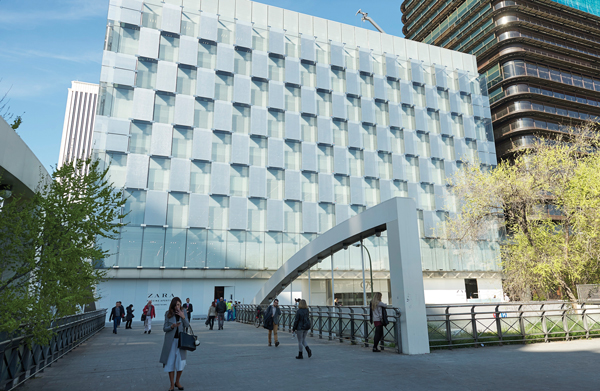Zara founder Amancio Ortega’s empire is rooted in retail, so it’d be no surprise if it were going the way of the current market: rapidly downhill. But as competitors like Bebe, BCBG Max Azria and The Limited fall like dominoes and corporate retailers shed real estate assets amid the great retail recession, Ortega appears to be headed in the opposite direction.
In April, Zara announced it would open its largest store, a 65,000-square-foot behemoth, in the heart of Madrid’s financial center, Paseo de la Castellana. The same month, the discount retailer announced its biggest location in the United Kingdom, a 41,731-square-foot storefront in London’s Westfield Shopping Centre.
Ortega is the richest man in Europe and the fourth-richest man in the world, according to Forbes, with a personal net worth of $82.3 billion as of May. Echoing the larger battle being waged between e-commerce and brick-and-morter retail, the 81-year-old Spaniard briefly took second place on the world’s richest list earlier this year, temporarily pushing Amazon’s Jeff Bezos down a rung before resuming his fourth-place position.
As the majority shareholder of Inditex — which controls Zara, as well as retailers Bershka, Massimo Dutti, Oysho, Pull and Bear, Stradivarius, Uterque and Zara Home — Ortega will be getting a $1.26 billion dividends payment after his company posted a net profit of $3.2 billion in 2016, a 10 percent bump over the previous year.
As an added bonus, over the last decade Ortega’s share of Inditex’s profits has given the fashion tycoon the capital to amass more than $10 billion in trophy properties from Miami and Beverly Hills to London — relatively debt-free.
It’s part of a global business strategy that has propelled Ortega from the poor son of a railway worker and a housemaid to the Forbes billionaires list. But it isn’t the only reason. Another factor is a shift in consumer habits toward fast fashion. And no one is getting clothes from the runway to the racks faster than Zara.
Fast fashion
A notoriously media-averse chief executive, Ortega doesn’t do press interviews (and declined to comment for this article), but retail and commercial real estate experts say his vertical strategy gave Zara the ability to implement aggressive production schedules so that stores were stocked with fresh apparel twice a week. Materials for all Inditex brands originate in Spain, Portugal and Morocco, which are cut, finished and treated in mills and then sewn by local shops in Galicia, Spain. By controlling the supply chain, Inditex can adapt to new fashion trends quickly.

Amancio Ortega
Liz Holland, chairwoman of the International Council of Shopping Centers and CEO of commercial real estate investment firm Abell Associates, said Inditex figured out the perfect model for fashion at affordable prices that can be produced in a quick turnaround.
“In terms of going from runway to sales floor, Zara is winning the race,” Holland said. “And the company has done a great job of tapping into the desires of a cash-strapped customer base.”
Arik Kislin, principal of Linx Industries (a diversified investment company), credited Zara’s ability to move quickly in response to trends as a key to its success.
“They produce on-demand product in the shortest amount of time compared to their competitors,” Kislin said. “To do that, Ortega has built a very strong infrastructure. He knows the business inside and out.”
Getting up to speed
Ortega’s fast-fashion empire was not built in a day. His early life was marked by political violence and abject poverty. He was born on March 28, 1936, four months before the three-year Spanish Civil War broke out. Xabier Blanco, a Spanish journalist who’s authored biographies about Ortega and his first wife, the late fashion icon Rosalia Mera Goyenechea, said the couple are part of the generation who lived through the iron grip of General Francisco Franco for 36 years.
Ortega told the biographer that when he was a child, he witnessed a grocer refusing to extend credit to his mother because the family was so poor. The humiliation Ortega’s mother experienced was a defining moment for the clothing mogul.
“They grew up in very hard conditions,” Blanco said in an interview with The Real Deal. “During that era, the attitude was, ‘You have to work immensely hard in order to progress.’”
When Ortega turned 13, he went to work for a shirtmaker in La Coruña, his adopted hometown in the Galicia region where Inditex is now headquartered. He met Mera in a clothing store where she was a shop assistant and he was a manager; they married in 1966. The pair soon partnered with Ortega’s brother Antonio to create dressing gowns and lingerie designed by Mera. They sold the line from their garage.
Ortega quickly adopted a vertical strategy that still serves as the cornerstone of his vast retail holdings. When most retailers focused on one aspect of the business such as making, distributing or selling clothes, Ortega did all three. It helped that he could tap into Galicia’s skilled workforce of female embroiderers and seamstresses, Blanco said.
By 1975, Ortega opened a factory, employed 500 people and was selling clothes across Spain. He opened the first Zara store in La Coruña, which still exists. Ortega’s labor force allowed him and his partners to make and distribute new clothes at a fast clip in response to consumer demand.
Ten years later, Ortega and Mera formed Inditex, basing it inside a stone fortress in Arteixo, an industrial town in the outskirts of La Coruña. When the couple divorced in 1986, Mera retained a 7 percent stake in the company and was crowned the world’s wealthiest self-made female entrepreneur, with a net worth of more than $6 billion, by Forbes in 2013, the year she died.
Coming to America
In late 1986, retail broker Faith Hope Consolo [TRDataCustom] was in the lobby of the Waldorf Astoria at 301 Park Avenue to meet with her new client, Ortega. At the time, Consolo’s job was to recruit foreign retailers to the U.S. for the brokerage Garrick-Aug Associates Store Leasing, she said.
“A few weeks earlier, I was in Barcelona doing some good old-fashioned can-
vassing when I saw one of his stores,” Consolo said. “I went in and it was an incredible experience. I told myself, ‘This is something that can be very unique back in the U.S.’”

Inditex, Zara’s parent company, has more than 7,000 stores and employs about 160,000 people.
Consolo, now chairwoman of Douglas Elliman’s retail group, remembers Ortega was very low-key and very congenial during their first encounter at the Waldorf.
“For such an important and hugely successful businessman, he is the most gentlemanly [man] I have certainly met in the real estate business,” Consolo said. “Even at that early juncture, he had accomplished so much. Yet he could have been your next-door neighbor.”
Ortega told her he wanted to open the first U.S. Zara store near the Blooming-
dale’s in Manhattan. On a napkin, he jotted down how much space he sought: 15,000 square feet.
“Back then, that was unheard of,” Consolo said. “There were no superstores or big-boxes in the city. Most retailers took out 2,000 or 3,000 square feet. I kept asking him, ‘Are you sure?’” She was also surprised when Ortega told her he owned most of Zara’s locations in Europe.
“From the very beginning, he operated a fully integrated company,” Consolo said. “Although I convinced him to lease space at 750 Lexington Avenue, which was under construction in 1986.”
A year later, Zara opened the doors to its first U.S. store across the street from Bloomingdale’s — a location that still exists. Ortega went on to buy properties on Fifth Avenue and lower Broadway that currently house Zara stores. “He is a game changer. He’s got a global approach, whether it’s retail or real estate,” Consolo said.
About 6,000 people work at Inditex’s HQ these days, with another 154,000 employees scattered across the globe, which is populated with more than 7,000 retail stores under the company umbrella.
Even now that he is among the top five billionaires in the world, Ortega’s work ethic endures. Despite stepping down as chairman seven years ago, he still maintains nine-hour workdays at Inditex HQ, according to his biographer.
“Amancio continues going to the factory every day,” Blanco said. “Working remains the number one priority in his life.”
Road to real estate
Market watchers say Inditex’s record growth and profits will inevitably recede, and Ortega has already set about finding other avenues of revenue. Investing in commercial real estate on high streets across the world is a smart way to ensure Inditex is well-leveraged beyond his death, observers note.
“The white elephant in the room is that the man is 81 years old,” Linx Industries’ Kislin says. “Retail is how he grew his empire, but it is an operating business you constantly have to reinvent yourself in. In real estate, when you have something iconic and with low leverage as he has, you avoid losing your assets and positions as we had so many people lose in 2008 when the economy tanked.”
Ortega’s real estate assets are all held under his other company, Pontegadea Inversiones, which reported an income of 810 million euros in 2015, up 5.2 percent compared with the previous year, according to a Reuters report last July. The massive dividend payouts Ortega has received from Inditex in the last seven years has given him the debt-free capital to snatch up prime buildings in Asia, North America and Europe.
The buying binge began in 2011, when Ortega purchased the Madrid office building Torre Picasso for 400 million euros, or around $556 million at the time. Because he offered all cash, Ortega was able to beat an offer from Manhattan-based Tishman Speyer, which owns Rockefeller Center, the Chrysler Building and London’s Tower Place.
His other real estate assets in Spain include a Barcelona building that houses an Apple store, for which he paid $165 million, and another Apple store property in Valencia he picked up for $30 million in 2013.
In London, his holdings include the Devonshire House, a 1920s office building in the city’s Mayfair district across from the Ritz Hotel, and the Almack House, a historic property situated between St. James’s Square and St. James Street. He paid £410 million ($680 million at the time) for the former and £225 million ($333 million at the time) for the latter.
In the U.S., Pontegadea has purchased more than $300 million in Midtown Manhattan office buildings and a North Rodeo Drive property housing a Gucci store for almost $108 million. An entire Lincoln Road block in Miami Beach cost him $370 million, and he spent $500 million on downtown Miami’s Southeast Financial Center.
The retail properties Ortega owns allow him a double benefit. For one, some of his biggest tenants are Inditex brands, which will never leave because he owns them, and Ortega doesn’t have to worry about landlord rent increases. At the same time, he also gets to lease prime retail space at market rates to some of his rivals like Primark, an Irish department store chain that currently has a location in an Art Deco building Ortega owns on Madrid’s main shopping drag, Gran Via.
Ortega biographer Blanco said the Zara mogul has never believed in the stock market. “One day you are up; the next day you are down.”
By acquiring signature properties, Ortega is providing Inditex with the means to leverage assets in the future.
“He is assuring not only the company’s future, but those of his daughter, his wife and his brothers, who all work for Inditex,” Blanco said. “And Inditex isn’t done growing. He hasn’t conquered North America. And he still has time to go after China and India.”
